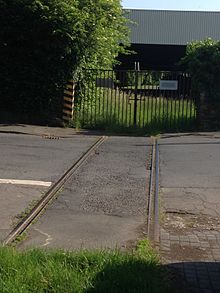Kleinbahn Neuwied – Rasselstein – Augustenthal
The single-track Neuwied-Rasselstein-Augustenthal small railway consists of two standard-gauge sections that are used exclusively for freight traffic.
Route description
The first section leads from the Neuwied state train station in the Wiedtal up to the Rasselstein company . The second section, which was closed in the meantime, represented the extension to Augustenthal (5.1 km) and had a stop and loading point with at least seven points at 4.0 km in Niederbieber - Segendorf .
There was also a storage building with a loading ramp on the railroad and street side. On its north side was a horse trough. In the neighborhood there was a wood loading station and a sawmill from the van Roje company .
From the Niederbieber-Segendorf loading point, the railway continued upstream. Shortly before the Friedrich Boesner GmbH screw and chain factory in Augustenthal, a bridge led the "track" over the Wied.
history
The first part was opened on May 1st (11th) 1891 by Rasselsteiner Eisenwerks-Gesellschaft AG in Neuwied-Rasselstein, the second on October 18th / November 29th, 1897 by the company "Friedrich Boesner GmbH" in Augustenthal near Neuwied.
From 1892 to 1893 there were political efforts to expand the line as a branch of the Westerwaldbahn through the Wiedtal to Wiedmühle near Neustadt (Wied) and then on to Altenkirchen . However, this plan failed due to profitability tests, although the train station in Wiedmühle was already designed accordingly.
In 1939 the Deutsche Reichsbahn (RBD Cologne) ran the business; however, the Rasselstein company owned two steam locomotives , 75 freight cars and 33 special cars . The two railways have been operated as private connecting railways since 1939.
Today only the section from the Neuwied train station to the Rasselstein factory premises is used. This is used daily by block trains with steel coils . The section leading up the Wied once served the scrap dealer “Ferrum”, then the sawmill “van Roje”, then the Niederbieber municipal railway station and after a short section through Segendorf reached the screw manufacturer “Friedrich Boesner” in Augustenthal. This owned the route from Rasselstein, on which the last wagon was carried in January 1991. The restoration of this section failed in 1999 due to the high costs of replacing the ailing rails and switches.
literature
- K. Wolfram: The economic and historical development of the city of Neuwied , p. 90, Verlag Peter Kehrein, Neuwied 1927

